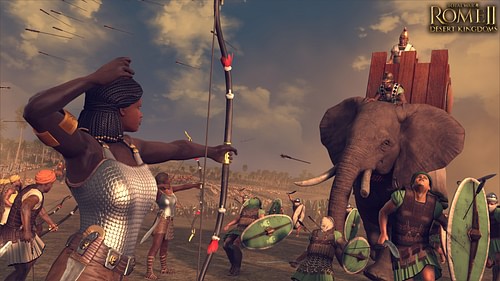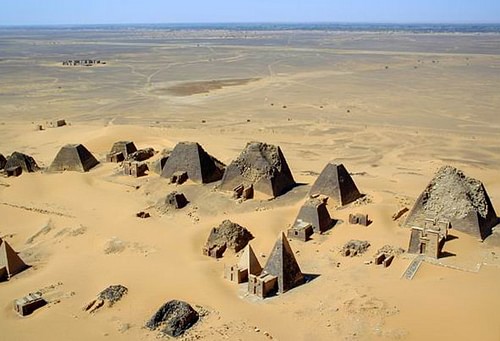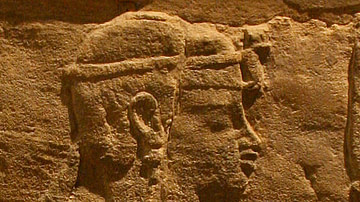
Kush was a kingdom in northern Africa in the region corresponding to modern-day Sudan. The larger region around Kush (later referred to as Nubia) was inhabited c. 8,000 BCE but the Kingdom of Kush rose much later. The Kerma Culture, so named after the city of Kerma in the region, is attested as early as 2500 BCE and archaeological evidence from Sudan and Egypt show that Egyptians and the people of Kush region were in contact from the Early Dynastic Period in Egypt (c. 3150 - c. 2613 BCE) onwards. The later civilization defined as 'Kushite' probably evolved from this earlier culture but was heavily influenced by the Egyptians.
While the history of the overall country is quite ancient, the Kingdom of Kush flourished between c. 1069 BCE and 350 CE. The New Kingdom of Egypt (c. 1570-1069 BCE) was in the final stages of decline c. 1069 BCE, which empowered the Kushite city-state of Napata. The Kushites no longer had to worry about incursions into their territory by Egypt because Egypt now had enough trouble managing itself. They founded the Kingdom of Kush with Napata as its capital, and Kush became the power in the region while Egypt floundered.
Kushite kings became the pharaohs of Egypt's 25th Dynasty and Kushite princesses dominated the political landscape of Thebes in the position of God's Wife of Amun. The Kushite king Kashta (c. 750 BCE) was the first to establish himself on the Egyptian throne and appointed his daughter, Amenirdis I, the first Kushite God's Wife of Amun. He was followed by other great Kushite kings who reigned until the Assyrian invasion of Egypt by Ashurbanipal in 666 BCE.
In c. 590 BCE Napata was sacked by the Egyptian pharaoh Psammeticus II (595-589 BCE) and the capital of Kush was moved to Meroe. The Kingdom of Kush continued on with Meroe as its capital until an invasion by the Aksumites c. 330 CE which destroyed the city and toppled the kingdom. Overuse of the land, however, had already depleted the resources of Kush and the cities would most likely have been abandoned even without the Aksumite invasion. Following this event, Meroe and the dwindling Kingdom of Kush survived another 20 years before its end c. 350 CE.
Name
The region was known by the Egyptians as Ta-Sety (“The Land of the Bow”), in reference to skilled Kushite archers, by the time of the Old Kingdom of Egypt (c. 2613-2181 BCE) and the northern area, bordering Egypt, as Wawat. What Kush was called by its inhabitants at this time is unclear; perhaps it was always known as Kush – or some variant thereof – since Egyptian inscriptions also refer to it as Kus, Kas, and Kash. The designation 'Kush' seems to be indigenous while the later name for the same region, Nubia, came most likely from the Egyptians to the north.
The region of Kush was the main source of gold for the Egyptians, and it is thought that 'Nubia' derived from the Egyptian word for gold, 'nub'. There is another theory, however, which claims that 'Nubia' derives from the people known as the Noba or Nuba who settled there. The Egyptians also knew the land as Ta-Nehsy (“Land of the Black People”). Greek and Roman writers referred to the region as Aethiopia (“Land of the Burnt-Faced Persons”) in reference to the indigenous peoples' black skin, and the Arab tribes knew it as Bilad al-Sudan (“Land of the Blacks”). It should be noted, however, that these designations may or may not have been referencing the whole region.
Kerma & Early Kush
The city of Kerma was established in Kush by c. 2400 BCE and was powerful enough to threaten Egypt as attested by Egyptian inscriptions and forts built to repel raids from the south. Even so, the kings of Kerma and Egypt established a lucrative trade for both parties and Egypt relied on Kerma for the import of gold, ebony, incense, exotic animals, and ivory among other luxury items.
The city centered around a structure known as a deffufa, a fortified religious center created from mud brick and rising to a height of 59 feet (18 meters). Interior passageways and stairs led to an altar on the flat roof where ceremonies were held but what these services entailed is unknown. The largest deffufa (the term means 'pile' or 'to mass') is known today as the Western Deffufa, and there is a smaller one to the east and a third which is even smaller. It is thought these formed a triad of a religious center around which the city then rose and was enclosed by walls.
The Kerma Culture is thought to have flourished between c. 2400 - c. 1500 BCE. The Egyptian king Mentuhotep II conquered the region at the beginning of the Middle Kingdom (2040-1782 BCE) but Kerma remained a thriving metropolis and was powerful enough by the time of the Second Intermediate Period of Egypt (c. 1782 - c. 1570 BCE) to threaten Egypt in conjunction with the people known as the Hyksos who had established themselves as a political and military power in Egypt's northern Delta region.
The Kushites of Kerma and the Hyksos engaged in trade with the Egyptians at Thebes until Ahmose I (c. 1570-1544 BCE) drove the Hyksos from Egypt and then marched south to defeat the Kushites. Egyptian campaigns into Kush continued during the reigns of Thutmose I (1520-1492 BCE) and Thutmose III (1458-1425 BCE). The end of the Kerma period is usually given as c. 1500 BCE when Thutmose I attacked the city. Thutmose III then founded the city of Napata after his campaigns which consolidated Egyptian power in the region.
Napata
Napata was clearly influenced by Egyptian culture from its very beginning. Rulers were buried beneath pyramid tombs with Egyptian grave goods, making dating certain graves difficult since a relatively recent grave of a Kushite king might contain items from 200 years before his reign. The lack of a written record also makes positive dating difficult. Scholar Derek A. Welsby notes how “studying the Kingdom of Kush is like a detective story in which a number of disparate and often apparently contradictory facts must be woven into a coherent and plausible narrative of events” (9). Even so, it is clear that Napata was the religious center of the region and became a wealthy city due to trade.
Thutmose III built the great Temple of Amun below the nearby mountain of Jebel Barkal which would remain the most important religious site in the country for the rest of its history, with later Egyptian pharaohs such as Ramesses II (1279-1213 BCE) adding to the Temple of Amun and the city. The priests of Amun, fairly quickly, were exercising the same kind of political power over Kushite rulers that they had with Egyptian kings since the time of the Old Kingdom.
As the New Kingdom declined c. 1069 BCE, however, Napata grew stronger as a political entity independent of Egypt. The priests of Amun in Egypt had been steadily gaining even greater power at Thebes and by the time of the Third Intermediate Period of Egypt (c. 1069-525 BCE) the high priest at Thebes ruled Upper Egypt while the pharaoh ruled Lower Egypt from the city of Tanis.
Egypt's weakness was Kush's strength, and the Kingdom of Kush is first dated to c. 1069 BCE when the Kushite kings were able to reign without fear or reference to Egyptian monarchs or policies. Napata was chosen as the capital of the new kingdom which continued to trade with Egypt but were able to expand their commerce now with other nations. Kings at first were still buried at Kerma but eventually the royal necropolis was established at Napata. The kingdom grew steadily until it was powerful enough to take what it wanted from Egypt whenever it pleased, and yet when this time came, they did not enter Egypt as conquerors but as rulers intent on preserving Egyptian culture.
The 25th Dynasty
The Third Intermediate Period in Egypt, although not as chaotic and dark as early Egyptologists have claimed, saw a general decline in the wealth and international prestige of the nation. At the same time, Kush was flourishing and the first Kushite king known by name, Alara, unified the kingdom and consolidated religious rites centered at Napata. His dates are unknown (although many have suggested possibilities), and he would become a legendary figure to the people of Kush for his long and prosperous reign, but his existence is verified through ancient inscriptions and the discovery of what is most likely his tomb.
His successor, Kashta, held a great admiration for Egyptian culture, importing artifacts from the north and "Egyptianizing" Napata and the Kingdom of Kush. As Egypt declined, and power in Lower Egypt had less and less reach into Upper Egypt, Kashta quietly had his daughter Amenirdis I appointed God's Wife of Amun at Thebes. He was no doubt able to do this owing to the relationship between the Priests of Amun at Napata and those at Thebes, although no documentation attests to this. The position of God's Wife of Amun, first established during the Middle Kingdom, had grown in importance to the extent that, by Kashta's time, a woman holding the position was the female equivalent of the High Priest of Amun and had enormous wealth and political power.
Amenirdis I took control of Thebes and then simply claimed rule of Upper Egypt. The princes of Lower Egypt at this time were engaged in their own conflicts with each other and so Kashta arrived at Thebes and declared himself King of Upper and Lower Egypt. Without raising an army or initiating any kind of conflict with the Egyptians, he founded the 25th Dynasty of Egypt under which the country was ruled by a Kushite monarchy. Kashta did not live long after his success, however, and was succeeded by his son Piye (747-721 BCE).
There is no record of the reaction of the princes of Lower Egypt to Kashta's declaration but they strongly objected to Piye's efforts to consolidate Kushite rule in the country. Piye did not negotiate with those he saw as rebel princes and marched his army north, conquering all the cities of Lower Egypt, and then returned to Napata. He allowed the conquered kings to retain their thrones, re-establish their authority, and continue on as they had previously; they simply had to acknowledge him as their lord. Piye never ruled Egypt from Thebes and does not seem to have given it much thought after his campaign.
Piye's brother, Shabaka (721-707 BCE) succeeded him and continued to reign from Napata. The royalty of Lower Egypt again rebelled, however, and Shabaka defeated them. He established Kushite control firmly throughout Lower Egypt all the way to the Delta region. Early 20th-century CE scholars claim that this was a “dark time” for Egypt when Nubian culture supplanted traditional Egyptian values but this cannot in any way be supported. So-called Nubian culture, by this time, was highly Egyptianized and, further, Shabaka admired Egyptian culture as much as his brother and father had. He continued to observe Egyptian policies and respected Egyptian beliefs. He had his son, Haremakhet, appointed High Priest of Amun at Thebes, effectively making him ruler of Egypt, and embarked on a series of building projects and reconstruction efforts throughout the country. Shabaka, far from destroying Egyptian culture, preserved it.
Shabaka's younger brother (or nephew), Shebitku (707-690 BCE) succeeded him and began well until he came into conflict with the Assyrians. The Egyptians had maintained a buffer zone between their northern borders and the region of Mesopotamia which had been lost by this time. Kingdoms such as Judah and Israel had now rebelled against domination by the Assyrians of Mesopotamia and Shabaka had given sanctuary to a rebel leader, Ashdod, who had revolted against the Assyrian king Sargon II (722-705 BCE). The 25th Dynasty continued to support these kingdoms against the Assyrians, and this brought the Assyrian army to Egypt under their king Esarhaddon in 671 BCE.
Esarhaddon met the Kushite king Taharqa (c. 690-671 BCE) in battle, defeated him, captured his family and other Kushite and Egyptian nobles, and had them sent back to Nineveh in chains. Taharqa himself managed to escape and fled to Napata. He was succeeded by Tantamani (c. 669-666 BCE) who continued to antagonize the Assyrians and was defeated by Ashurbanipal who conquered Egypt in 666 BCE.
The Great City of Meroe
The 25th Dynasty ended with Tantamani, and he was replaced by the Assyrians with a puppet king known as Necho I. Necho's son, Psammeticus I (also known as Psamtik I, c. 665-610 BCE), threw off Assyrian rule and founded the 26th Dynasty of Egypt. Psammeticus I and his successor, Necho II, ruled well, but Necho II's successor, Psammeticus II, felt he needed a glorious military campaign in keeping with the great pharaohs of the New Kingdom. He, therefore, led an expedition against Kush, destroying towns, temples, monuments, stele, and finally the city of Napata before he grew bored with the campaign and returned to Egypt.
At this time, c. 590 BCE, the capital of the Kingdom of Kush moved further south to the city of Meroe for safety. The kings of Meroe continued to emulate Egyptian custom and fashion and follow Egyptian policy and religious practice until the reign of the king Arkamani I (also known as Ergamenes, 295-275 BCE). The Priests of Amun had long held power over the Kushite monarchy by allotting each king a certain amount of time to reign, and when their god indicated to them that time was up, the king had to die and another was chosen by the priests.
According to the historian Diodorus Siculus (1st century BCE), Arkamani I had been educated in Greek philosophy and refused to be controlled by the superstitions of the priests. He led a band of men to the temple, had all the priests slaughtered, and ended their power over the monarchy. He then instituted new policies and practices which included abandoning Egyptian culture, with an emphasis on Kushite. Arkamani I discarded hieroglyphic script in favor of another known as Meroitic which, to date, has not been deciphered. The fashion of the people of Meroe during his reign shifts away from Egyptian to distinctly Meroitic and the gods of the Egyptians become assimilated into Kushite deities such as Apedemak. The tradition of burying royalty at Napata was also abandoned and kings would thenceforth be entombed at Meroe.
Another interesting innovation of Arkamani I's reign was the establishment of female monarchs at Meroe. These queens, known as Candaces (also Kandake, Kentake) ruled between c. 284 BCE - c. 314 CE. Although they had male escorts in public ceremonies, they were not subject to male domination. The earliest recorded queen is Shanakdakhete (c. 170 BCE) who is shown in full armor leading her troops in battle. The title of Candace is thought to mean “Queen Mother” but exactly what this refers to is unclear. It may have meant “royal woman” or “mother of the king” initially but the queens who held the title appear as monarchs who were not defined by their relationship with men. One of these queens, Amanirenas (c. 40-10 BCE), led her people successfully through the Meroitic War between Kush and Rome (27-22 BCE) and was able to negotiate favorable terms in the peace treaty from Augustus Caesar.
Conclusion
Meroe, on the banks of the Nile, was an agricultural and industrial complex, as well as the capital of the Kingdom of Kush, and grew wealthy through its iron works and trade. Grains and cereals were exported along with iron weapons and tools and livestock roamed the fields around the city. Meroe was so wealthy that it became legendary and the Persian king Cambyses II (525-522 BCE) is said to have even launched an expedition to sack it. If said expedition was ever mounted, it never reached the city, and legend claims that Cambyses II's army was defeated by the inhospitable terrain they had to cross and the weather.
Large forests rose on the far side of the fertile fields surrounding the city which were irrigated by canals off the Nile. The upper class lived in large houses and palaces which looked down on broad avenues lined with statuary while the lower classes lived in mud-brick homes or huts. According to ancient inscriptions, even the poorest citizen of Meroe was still better off than anyone elsewhere. The Temple of Amun, in the center of the city, was reportedly its jewel and on par with the earlier temple at Napata.
In c. 330 CE the Axumites invaded and sacked Meroe. Although the city would continue on another 20 years, it was effectively destroyed by the Axumites. Even if the invasion had not come, however, Meroe was doomed and had brought this on itself. The iron industry required massive amounts of wood to create charcoal and fuel the furnaces for the iron resulting in deforestation of the once-plentiful forests. The fields were overgrazed by cattle and overused for crops, depleting the soil. Before the Axumites ever arrived, Meroe must have been in decline and would have had to be abandoned anyway. When the last of the people walked away from the city c. 350 CE, the Kingdom of Kush had come to an end.









